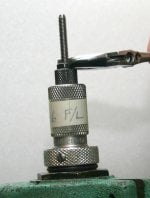In my ongoing search for the "Bug Hole" 30-06, 180 gr hunting load I have momentarily focused on neck concentricity of my cases. Broke into a new box of Nosler 30-06 cases and ran them over my RCBS concentricity gauge while some once fired cases were in the sonic washer.
New Nosler cases, with the case body supported in the gauge at the case head and just behind the shoulder, yielded 20 cases with the difference between neck high and low points 0.004" compared to 10 cases which were measured on the same gauge yielding 0.001" - 0.002".
Earlier this year I had attempted to "true up" the necks on new Nosler cases that were showing 0.005" of difference between high and low points, using my sizing die without bumping the shoulder back, and was unsuccessful. A Nosler Tech did send me 5 new cases for no charge.
The 20 once fired Nosler cases that came out of the cleaner all measured 0.001 or less difference when measured on the gauge. I will be loading them for load testing with IMR4451 and Nosler 180 Partitions.
What would you do with the cases showing the most, 0.004+" runout? Load and fire form to true the necks? Call Nosler again? Look for Norma and/or Lapua brass to compare? Any suggestions will be most appreciated. Thanks in advance.. Rol
New Nosler cases, with the case body supported in the gauge at the case head and just behind the shoulder, yielded 20 cases with the difference between neck high and low points 0.004" compared to 10 cases which were measured on the same gauge yielding 0.001" - 0.002".
Earlier this year I had attempted to "true up" the necks on new Nosler cases that were showing 0.005" of difference between high and low points, using my sizing die without bumping the shoulder back, and was unsuccessful. A Nosler Tech did send me 5 new cases for no charge.
The 20 once fired Nosler cases that came out of the cleaner all measured 0.001 or less difference when measured on the gauge. I will be loading them for load testing with IMR4451 and Nosler 180 Partitions.
What would you do with the cases showing the most, 0.004+" runout? Load and fire form to true the necks? Call Nosler again? Look for Norma and/or Lapua brass to compare? Any suggestions will be most appreciated. Thanks in advance.. Rol





